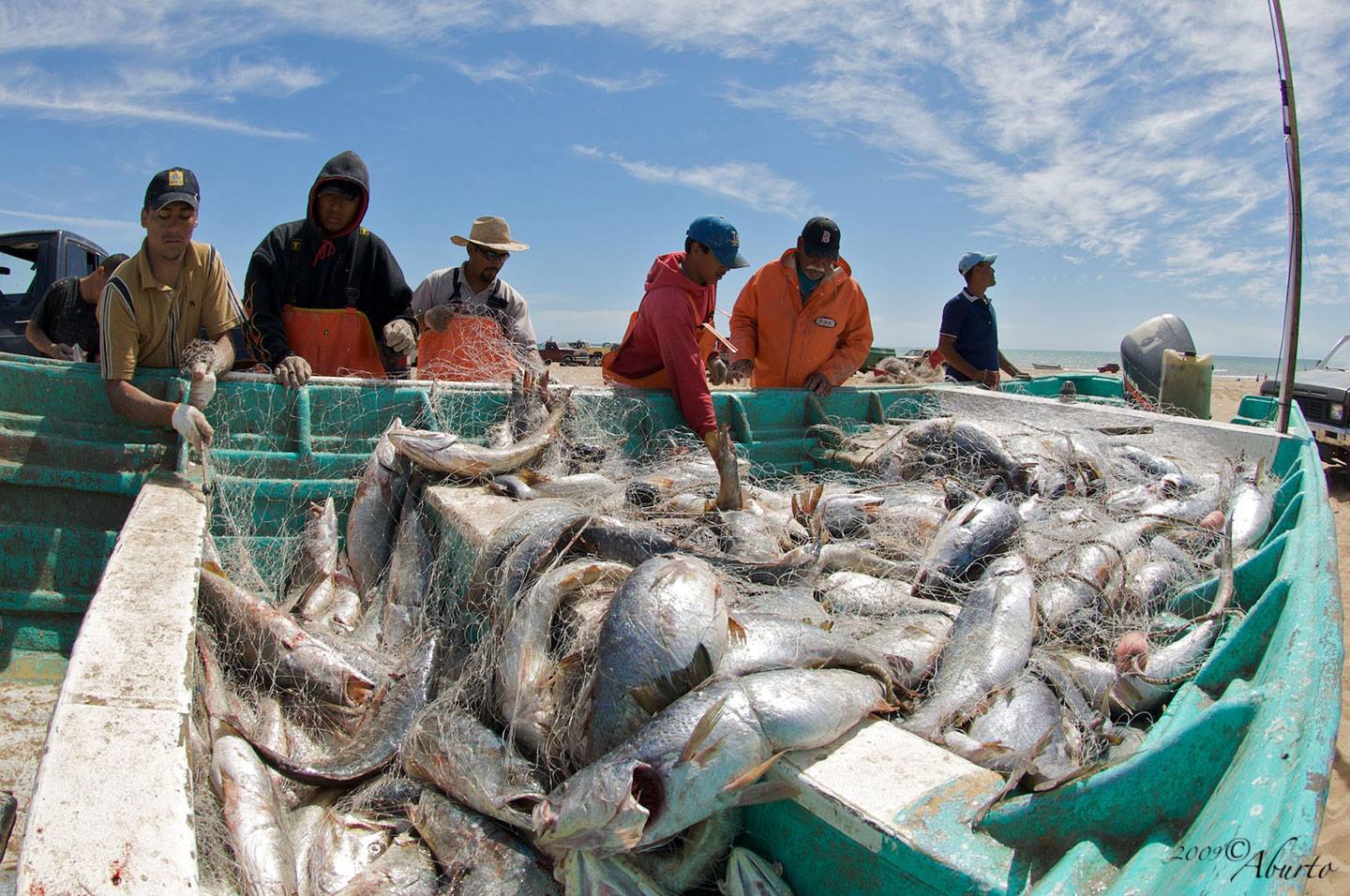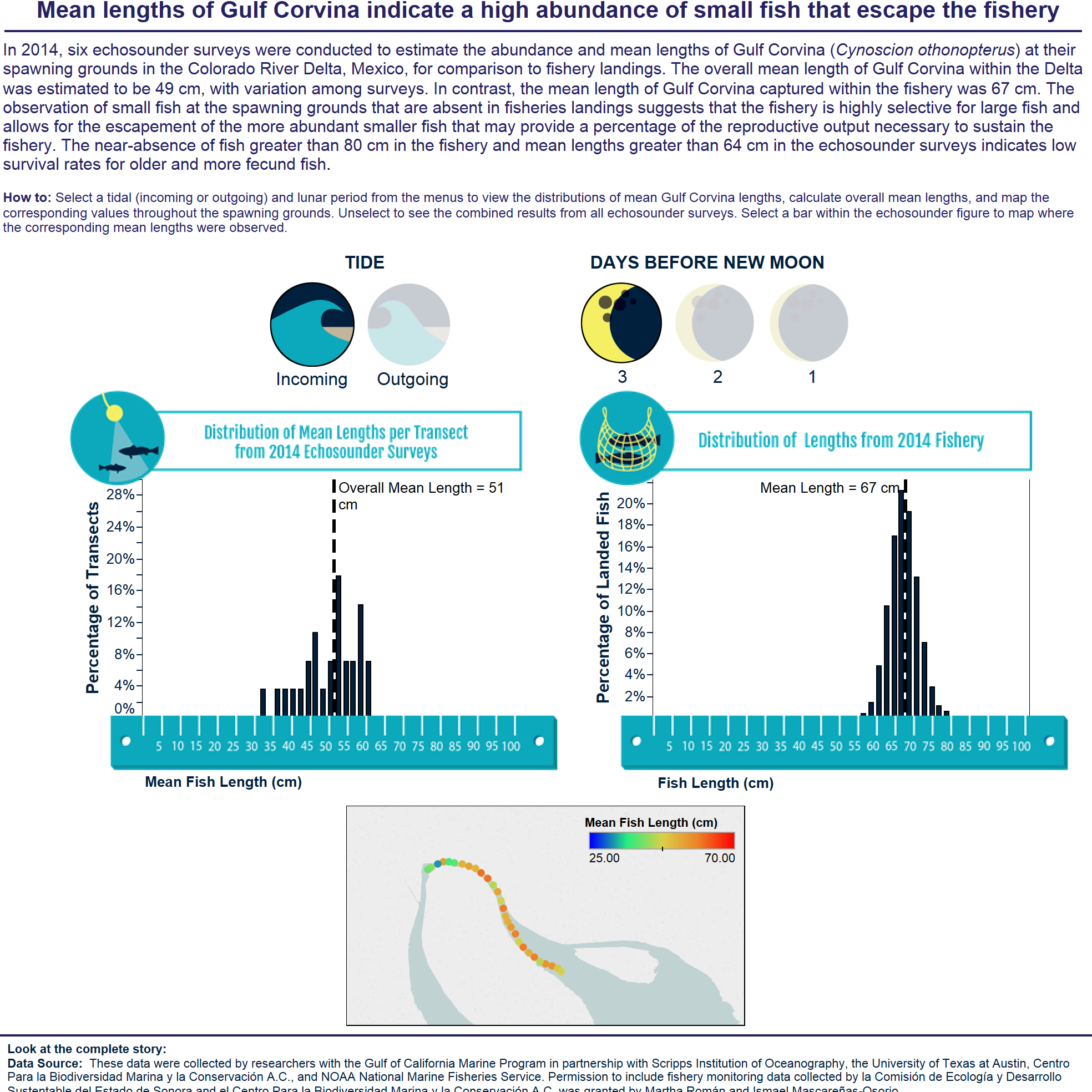Echosounder surveys reveal that small fish escape from the Gulf Corvina fishery.

Every spring, adult Gulf Corvina (Cynoscion othonopterus) return to where they were born in the Colorado River Delta of the Upper Gulf of California, Mexico. The purpose of this journey is to gather with millions of other Corvina to reproduce on the days prior to the new and full moons in the months of February through June (1). The predictability and size of these spawning events support a productive fishery in which the communities of El Zanjón, El Golfo de Santa Clara, and San Felipe harvest up to 6,000 metric tons seasonally (1). Given the economic importance of this fishery and the susceptibility of spawning aggregations to overfishing (2), the Corvina Technical Group (CTG) was formed in 2011 to monitor the fishery, collect fisheries-dependent data, and facilitate sustainable resource use (3).

Each year the CTG samples fishery landings to determine the lengths of fish captured, as well as weights, sex ratios, ages, and total landing biomass, among others (3). More information can be seen here . While this information is invaluable for managing the fishery, it is solely dependent on fisheries landings and does not directly examine the entire population that is present at the spawning grounds. To get a better understanding of Gulf Corvina lengths and abundance in the Delta, scientists surveyed the spawning grounds in 2014 (March and April) with an echosounder, which functions by sending an acoustic beam into the water that can detect the number of fish present underwater as well as estimate fish lengths (4 ). Echosounder surveys were conducted on 3, 2, and 1 days before the new moon when the abundance and spawning activity of Gulf Corvina is highest. A total of two surveys were completed per day, one on the incoming tide and one on the outgoing tide, to understand differences in fish lengths with tidal period. The resulting data were used to estimate the mean lengths of Gulf Corvina in the spawning aggregation for comparison to the lengths recorded in the fishery by the CTG.
Major Findings:
Over the course of three days and a total of 155 echosounder transects in March and April 2014, the mean length of Gulf Corvina present at the spawning grounds and exposed to fishing activities was estimated to be 49 cm. Mean lengths varied from 26 cm to 64 cm across transects and 38 cm to 51 cm across the six surveys. Mean lengths per survey were quite similar on all surveys (49 cm – 51 cm) and did not change much with lunar or tidal period, excluding the incoming tide one day before the new moon (38 cm) when an aggregation of large fish was not detected. These combined findings and a lack of mean fish lengths greater than 64 cm indicated a large presence of smaller fish within the Delta that outnumber the quantity of larger fish.
Fishery landings from the same time period in 2014 were comprised of fish of lengths 36 – 92 cm, as recorded by the CTG. The mean length of Gulf Corvina captured by the fishery was 67 cm. By comparing mean lengths from echosounder surveys (49 cm) with the lengths of fish landed by the artisanal fishery (67 cm), it is apparent that the nets used by fishers are selective for larger fish and that the majority of fish at the spawning aggregation are smaller and not prone to capture by the fishing gear.
This study suggests that untargeted smaller fish were present and likely spawning on all surveys, which is likely to be extremely important for the reproductive success of the aggregation. Their potentially large contribution to the reproductive output during spawning events provides a plausible explanation into why the high fishery landings have been sustained for so many years.
Authors:
Timothy J. Rowell †, Brad Erisman ‡
Contact Information:
DOI:
10.13022/M3W01T
Affiliations:
†Marine Biology Research Division, Scripps Institution of Oceanography, La Jolla, CA USA; ‡ The University of Texas at Austin, Marine Science Institute, Port Aransas, TX USA
Acknowledgements:
We are grateful for the help of J. J. Cota Nieto, A. Montes, J. Cabrera Rivera, J. Montañez Rivera, E. Cabrera Rivera, Y. Flores, C. López-Sagástegui, O. Aburto-Oropeza, CONAPESCA, and CONANP for their efforts in helping with project logistics. We are indebted to D. Demer, J. Hyde, T. Sessions, J. Zwolinski, J. Renfree, and S. Mau for their intellectual support. We express our gratitude to M. Román of the Comisión de Ecología y Desarrollo Sustentable del Estado de Sonora and I. Mascareñas-Osorio of the Centro Para la Biodiversidad Marina y la Conservación A.C. for providing fishery monitoring data.
How to cite this story:
Timothy J. Rowell, Brad Erisman (2016): Echosounder surveys reveal that small fish escape from the Gulf Corvina fishery. DataMares. InteractiveResource. http://doi.org/10.13022/M3W01T
References
- Erisman BE, Aburto-Oropeza O, Gonzalez-Abraham C, Mascareñas-Osorio I, Moreno-Báez M, Hastings PA (2012) Spatio-temporal dynamics of a fish spawning aggregation and its fishery in the Gulf of California. Sci Rep 2: 284. DOI: 10.1038/srep00284
- Sadovy Y, Domeier M 2005. Are aggregation-fisheries sustainable? Reef fish fisheries as a case study. Coral Reefs 24:254–262
- Rafael Ortiz, Ismael Mascareñas-Osorio, Martha Román, Julián Castro (2016): Biological and fisheries monitoring of the Gulf Corvina in the Upper Gulf of California. DataMares. InteractiveResource. http://doi.org/10.13022/M38590
- Jack Paul Egerton, Andrew Frederick Johnson, Alfredo Girón-Nava, Octavio Aburto-Oropeza (2016): Finding fish with sound at Cabo Pulmo National Park. DataMares. InteractiveResource. http://dx.doi.org/10.13022/M3JP4R

